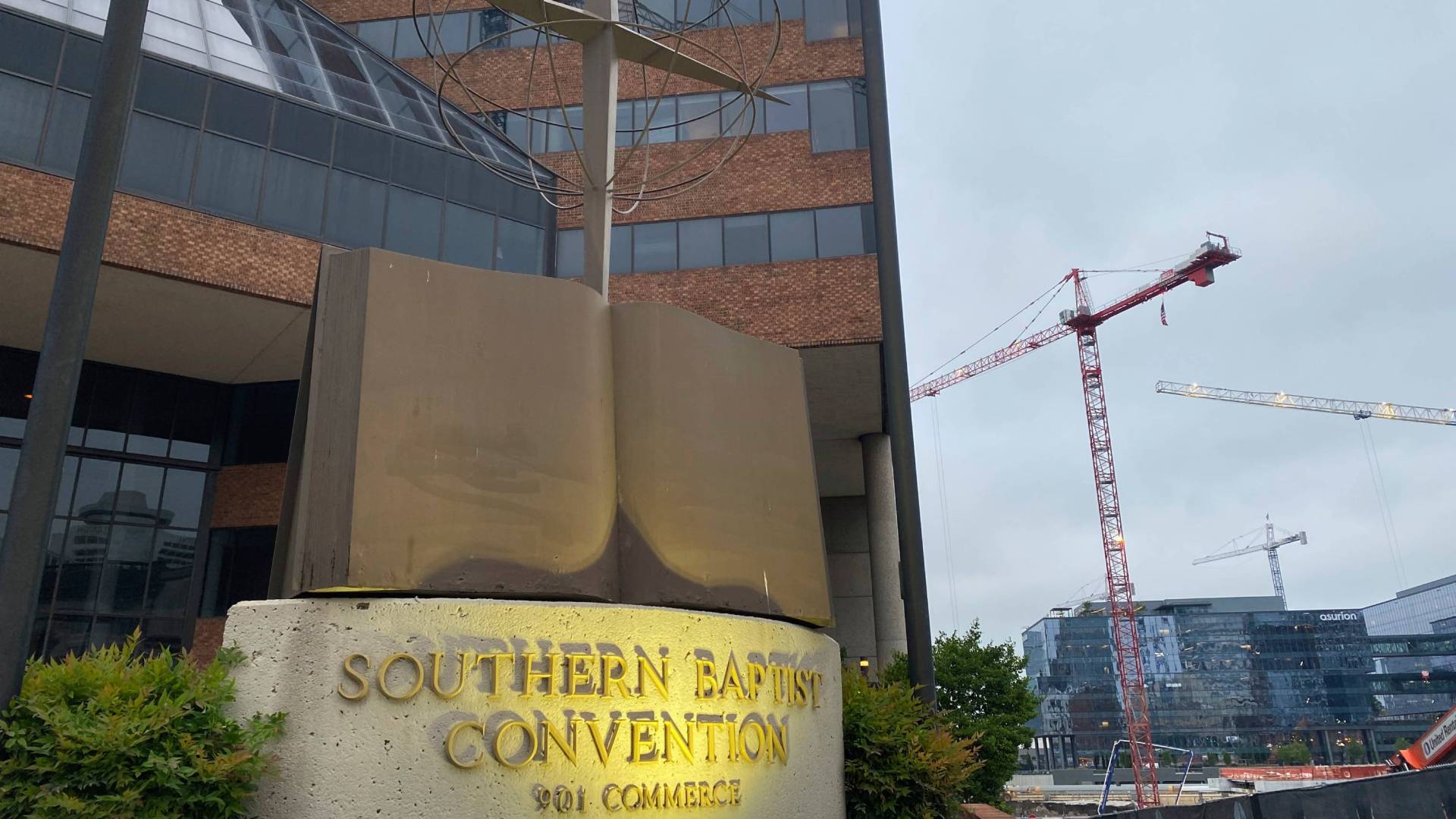The first thing you notice about Brenna Blain is probably her tattoos, a patchwork of ink stretching from her shoulders to her hands. A death’s-head hawkmoth spreads its wings around her neck, with a marking at its center that resembles a human skull.
For this 28-year-old Christian speaker and teacher in the Pacific Northwest, her brazen ink isn’t a liability—it’s an invitation. The neck tattoo opens unlikely conversations with those she says “would never choose to talk to a Christian willingly.”
“It’s one of the best outreach tools I’ve ever had,” Blain told CT. “I’ve been invited into spaces I wouldn’t typically expect to be invited into because people have been more willing to hear me out just simply based on my physical appearance.”
Her look is bold and trendy: combat boots with shorts, soft knit hats, oversized glasses. But her voice and daring message are what have grabbed the attention of young millennial and Gen Z Christians, as she shares hard and beautiful stories of trusting in God.
On her podcast and Instagram feed, Blain’s discussions of issues like eating disorders, sexuality, and mental illness have shaken up a polished evangelical online space. She describes herself as “gnarly” and admits to hating things like “overly mushy and emotional moments at women’s conferences,” so her style draws a certain kind of seeker—those tired of Christian platitudes and ripe for honest wrestling.
This raw vulnerability evolved out of a traumatic childhood that led Blain to question God’s love. After her parents separated when she was 12, Blain was molested, discovered she was same-sex attracted, developed an eating disorder, began self-harming, and was later diagnosed with bipolar disorder.
Unlike Christian teachers who share lessons from difficult seasons long ago, Blain is young enough that these struggles are still with her—she was hospitalized just last year for suicidal ideation—and yet she continues to open up and point to God amid them.
Blain began her podcast in 2019, the start of a modest public career as a self-proclaimed contemporary theologian. Blain’s reach has grown steadily with speaking engagements, podcast invitations (she recently appeared on With the Perrys with Preston and Jackie Hill Perry), and conference keynotes (she was a featured speaker at Preston Sprinkle’s 2024 Exiles in Babylon conference). Her debut book, Can I Say That?, released last month.
Blain has become an unofficial spokeswoman for Christian women who have struggled with same-sex attraction and want to remain obedient to the biblical call for sexual morality. She didn’t want to be pigeonholed or make that her whole persona.
As she gained a following, she felt led to share how God was moving during the painful parts of her life. Instead of waiting for healing from depression or peace about her childhood sexual abuse, she wondered if she could simply share her brokenness and utter dependence on God right now with her audience. She felt God affirm that conviction, and her witness grew.
Jackie Hill Perry called her “the kind of theologian this generation has been asking for,” saying that through her stories and spiritual insights, “we may not find every question answered but at the very least, we will have important truths to carry us when everything is confusing.”
Gen Z suffers from distinctively poor rates of mental health, and Blain speaks to those circumstances. She has over 44,000 Instagram followers—many say they see her authenticity and honesty as a refreshing reprieve from polished leaders who seem to have it all together.
Blain embraces a tough theology that doesn’t always, or often, have closure here on earth. Complete healing is possible, but for many people, it comes only in the New Jerusalem. “If you are wrestling or trying to decide if you will wrestle or walk away, my encouragement is that you wrestle and that you wrestle well,” she wrote in an Instagram post.
She goes where God calls, despite the imperfect circumstances of mental illness, a lingering eating disorder, and occasional suicidal ideation. In the past five years, he’s called her to the microphone, the stage, the altar, the delivery room, and the book publishing house.
None of this was the plan back when she was a closeted 14-year-old reeling from the pain of abuse.
Even though Blain attended a conservative church and was homeschooled by a mom who made dinner every night, her upbringing wasn’t strict. Her parents gave her autonomy, like when they allowed her to dye her hair blue.
As a teen, though, Blain felt rudderless. She began sharing her attractions in secret online. She was terrified of others knowing, thinking of the hateful signs and slogans from Westboro Baptist Church, whose protests were in the news. The anxiety and depression pushed her toward despair.
When she opened up to her youth pastor, he thanked her for sharing and told her many people struggle with same-sex attraction. Despite her church’s biblically orthodox stance on sexuality, the condemnation she expected never came. This compassionate response was deeply formative.
After high school, Blain signed up for a trip with Youth with a Mission (YWAM), mostly as a way to get to Hawaii, where the team would be training for six months. She knew how to “play a Christian,” and the trip was merely a ticket out of her hometown.
She started off “so bored out of my gourd from listening to typical church kids’ stories that I might as well have been on Ambien.” But halfway through that trip, Blain had what she said was an undeniable encounter with God after witnessing a supernatural moment with a friend. After that, she felt called to become a wholehearted servant on a mission for the kingdom.
The transition was “rough.” As she continued to struggle with an eating disorder that nearly toppled her ability to finish the trip, Blain learned to trust God in uncertainty. “I told myself, even if I do get sent home … he has been faithful in all these things,” she said. “Even in this brokenness, he’s still here.”
Her struggle with same-sex attraction remained as well. She thought she’d remain celibate for life.
While on mission, she received a six-page letter from Austin Blain, a friend she barely knew from back home. She saw the connection as God’s perfect timing, changing her heart, drawing Austin near, and ultimately setting her up for what would come next—which was marriage, ministry, and motherhood.
The two remained platonic friends, exchanging long letters and phone calls for more than a year as they each completed their missions with YWAM (Austin went on his own trip just as Brenna returned). “By the time I got back, I think we already knew we wanted to get married before we even started dating,” Austin said in an interview with CT.
Despite still feeling same-sex attraction, Brenna believed God had orchestrated their relationship. Her sexual orientation was a “non-issue” for Austin.
“I felt like, if the Lord was who the Lord was, that he could do anything,” Austin told CT. “From my point of view, it was like, this is not bigger than the Lord.”
The two were soon married and now have two little boys, with whom Blain stays home while managing her ministry responsibilities in early mornings, naptimes, stolen moments, and evenings when Austin is home. Blain said staying “wildly scheduled” (she wakes up at 5:30 a.m. to run, sans headphones) keeps her mental health in check, but her days can range from writing sermons to “washing my 3-year-old’s poop off the back patio.”
Even among evangelicals who uphold a traditional view of marriage, there’s a range of approaches to same-sex attraction and identity, and Blain doesn’t fall neatly into one particular camp. She said she resonates with aspects of both Side B (which says same-sex orientation is not a sin but acting on it is) and Side Y (which says people shouldn’t identify themselves by their sexual orientation), but doesn’t label herself as either.
Blain believes she’ll always be same-sex attracted, which clashes with some Christian viewpoints that say such attraction is itself sinful. Blain sees same-sex attraction as a result of the Fall and, therefore, unwanted.
“While I do not believe it is sinful to have the temptation, I am not comfortable with the idea of ‘being okay with the temptation’ either,” she said. “James 1:14–15 is very clear on the implications of being apathetic towards our currently existing temptations.”
Abiding by Scripture, Blain said she works to put temptation “to death” through confession and accountability. Same-sex attraction, she said, should not disqualify believers from leadership or Christian commitment, even if it never subsides.
Blain leads a small group for high school girls at her church and stays in touch with her mentor from when she was around that age. The two women text daily, meet monthly, and practice confession regularly; her mentor even comes along on speaking trips when her husband can’t.
Blain counts veteran theologian and pastor Gerry Breshears as a mentor, calling him a “pastor to pastors”; she meets with him quarterly for prayer and consultation. Beyond that, Blain sees a Christian counselor monthly and names female teachers Phylicia Masonheimer, Lisa Bevere, and Jackie Hill Perry as role models and mentors of wisdom and encouragement over the past four years of her public ministry.
Blain also calls out churches that expect people to “live by the standards of Christ before getting to know the person of Christ” as homophobic. Blain referenced 1 Corinthians 2:14, which says those without the Spirit “cannot understand” or “discern” the truth.
She might use someone’s preferred pronouns as a modicum of respect since others aren’t yet in a relationship with God as she is—a controversial take for a theologically conservative believer.
On an episode of the Theology in the Raw podcast, Blain said she’s often been told that she’s “the reason LGBTQ teens commit suicide” and that her mixed-orientation marriage is destined for divorce. She takes it in stride, saying she’s confident in the truth of the Bible and convictions of her heart.
“When I get comments like that, I remember that most people are just responding out of fear and that is a very real thing, especially if they don’t know the peace of Jesus,” she said.
And not everyone loves her image. Blain said, for example, that some Christians find her skull tattoos “demonic” or “evil.” But she said they help others feel more comfortable opening up and sharing their stories with her.
“God created a moth out of nature that has a design that looks like a skull on it. Witches didn’t create it; God did,” Blain said in response to her critics. “The skull is a reminder that all face death, and what will it serve as a doorway for?”
This kind of sobering question is regular fodder for Blain’s platform. Small talk isn’t really in her wheelhouse. She’s here for the real thing, nobly serious about ideas that lead people in her community to say they “feel seen”—maybe for the first time—by her work.
“I feel everything [Blain] was saying as someone who has too attempted suicide many times,” said one commenter after seeing her story online.
She has also shared some of her darkest moments with her audience. In 2023, Blain posted a photo of herself in a hospital bed, hooked up to tubes and monitors, huddled beneath a blanket in the aftermath of an earlier suicide attempt.
“Suffering has clarified my theology,” she wrote in her new book. Blain claims saving grace in Jesus while living through sometimes debilitating mental illness, and she thinks Christians should be open and honest about that.
“People are starving to see real testimonies of what it means to live in the ‘now and not yet’ of this broken world,” she said.
“As someone struggling with an incurable disease and a history of mental illness, I feel seen and encouraged,” said one commentor on Instagram.
Nearly two years out from her last hospitalization, Blain is publicly discussing the harsh realities of mental illness, bucking stereotypical Christian talking points that advocate assured healing. “God is here with us, but He doesn’t always heal, He doesn’t always intervene, and He doesn’t always promise earthly rescue,” she wrote. “For most of us we live life by managing it. Remission isn’t a term used in regards to mental health.”
When well-known pastor John MacArthur recently claimed there is “no such thing” as mental illnesses like PTSD, OCD, or ADHD, calling them “noble lies” that “give the excuse to … medicate people,” Blain had harsh words in response.
“It’s as harmful as telling someone that their brain cancer does not exist,” Blain said. “Approximately 8 million deaths each year are attributable to mental disorders, whereas 17,200 people die from a malignant brain tumor.”
Blain knows some will be wary of her ministry considering her publicly known suicide attempt, but she doesn’t believe a mental illness should disqualify one from ministry. Such a condition, she said, shows others how to live out a process of surrender, suffering, and doubt while still clinging to God.
“The Bible is not a list of rules,” she wrote in Can I Say That? “It is a shovel that uncovers the sinful condition of our hearts, uproots us from our sinful selves, and replants us within God’s will and safety.”



















































